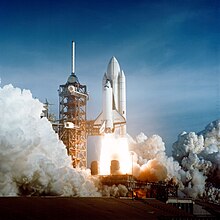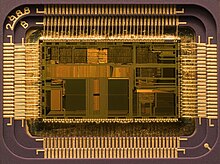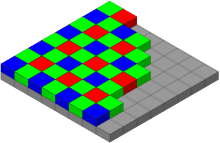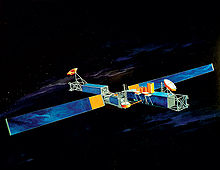"Electrical engineering" is a field of engineering that generally deals with the study and application of electricity, electronics and electromagnetism. The field first became an identifiable occupation in the late nineteenth century after commercialization of the electric telegraph and electrical power supply. It now covers a range of subtopics including power, electronics, control systems, signal processing and telecommunications.
Electrical engineering may include electronic engineering. Where a distinction is made, usually outside of the United States, electrical engineering is considered to deal with the problems associated with large-scale electrical systems such as power transmission and motor control, whereas electronic engineering deals with the study of small-scale electronic systems including computers and integrated circuits.[1] Alternatively, electrical engineers are usually concerned with using electricity to transmitenergy, while electronic engineers are concerned with using electricity to process information. More recently, the distinction has become blurred by the growth of power electronics.
------------------------------------------------
Electricity has been a subject of scientific interest since at least the early 17th century. The first electrical engineer was probably William Gilbert who designed the versorium: a device that detected the presence of statically charged objects. He was also the first to draw a clear distinction between magnetism and static electricity and is credited with establishing the term electricity.[2] In 1775, Alessandro Volta's scientific experimentations devised the electrophorus, a device that produced a static electric charge and, by 1800, Volta developed the voltaic pile, a forerunner of the electric battery.[3]
However, it was not until the 19th century that research into the subject started to intensify. Notable developments in this century include the work of Georg Ohm who, in 1827, quantified the relationship between the electric current and potential difference in a conductor, Michael Faraday, the discoverer of electromagnetic induction in 1831 and James Clerk Maxwell who, in 1873, published a unified theory of electricity and magnetism in his treatise Electricity and Magnetism.[4]
The Society of Telegraph Engineers (the forerunner of the Institution of Electrical Engineers, now the Institution of Engineering and Technology) was formed in 1871. This date is preserved by the telephone number of the IET's switchboard at its Savoy Place headquarters being currently 0207 240 1871.
During these years, the study of electricity was largely considered to be a subfield of physics. It was not until the late 19th century that universitiesstarted to offer degrees in electrical engineering. The Darmstadt University of Technology founded the first chair and the first faculty of electrical engineering worldwide in 1882. In the same year, under Professor Charles Cross, the Massachusetts Institute of Technology began offering the first option of Electrical Engineering within a physics department.[5] In 1883, Darmstadt University of Technology and Cornell University introduced the world's first courses of study in electrical engineering and, in 1885, the University College London founded the first chair of electrical engineering in the United Kingdom.[6] The University of Missouri subsequently established the first department of electrical engineering in the United States in 1886.[7]
During this period, the work concerning electrical engineering increased dramatically. In 1882, Edison switched on the world's first large-scale electrical supply network that provided 110 volts direct current to fifty-nine customers in lower Manhattan. In 1884, Sir Charles Parsons invented the steam turbine which today generates about 80 percent of the electric power in the world using a variety of heat sources. In 1887, Nikola Teslafiled a number of patents related to a competing form of power distribution known as alternating current. In the following years, a bitter rivalry between Tesla and Edison, known as the "War of Currents", took place over the preferred method of distribution. AC eventually replaced DC for generation and power distribution, enormously extending the range and improving the safety and efficiency of power distribution.
The efforts of the two did much to further electrical engineering—Tesla's work on induction motors and polyphase systems influenced the field for years to come, while Edison's work on telegraphy and his development of the stock ticker proved lucrative for his company, which ultimately became General Electric. However, by the end of the 19th century, other key figures in the progress of electrical engineering were beginning to emerge.[8]
Modern developments
During the development of radio, many scientists and inventors contributed to radio technology and electronics. In his classic UHF experiments of 1888, Heinrich Hertz transmitted (via a spark-gap transmitter) and detected radio waves using electrical equipment. In 1895, Nikola Tesla was able to detect signals from the transmissions of his New York lab at West Point (a distance of 80.4 km / 49.95 miles).[9] In 1897, Karl Ferdinand Braun introduced the cathode ray tube as part of an oscilloscope, a crucial enabling technology forelectronic television.[10] John Fleming invented the first radio tube, the diode, in 1904. Two years later, Robert von Lieben and Lee De Forest independently developed the amplifier tube, called the triode.[11] In 1895, Guglielmo Marconi furthered the art of hertzian wireless methods. Early on, he sent wireless signals over a distance of one and a half miles. In December 1901, he sent wireless waves that were not affected by the curvature of the Earth. Marconi later transmitted the wireless signals across the Atlantic between Poldhu, Cornwall, and St. John's, Newfoundland, a distance of 2,100 miles (3,400 km).[12] In 1920, Albert Hull developed the magnetron which would eventually lead to the development of the microwave oven in 1946 by Percy Spencer.[13][14] In 1934, the British military began to make strides toward radar (which also used the magnetron) under the direction of Dr Wimperis, culminating in the operation of the first radar station at Bawdsey in August 1936.[15]
In 1941, Konrad Zuse presented the Z3, the world's first fully functional and programmable computer.[16] In 1946, the ENIAC (Electronic Numerical Integrator and Computer) of John Presper Eckert and John Mauchlyfollowed, beginning the computing era. The arithmetic performance of these machines allowed engineers to develop completely new technologies and achieve new objectives, including the Apollo missions and theNASA moon landing.[17]
The invention of the transistor in 1947 by William B. Shockley, John Bardeen and Walter Brattain opened the door for more compact devices and led to the development of the integrated circuit in 1958 by Jack Kilbyand, independently in 1959, by Robert Noyce.[18] Starting in 1968, Ted Hoff and a team at Intel invented the first commercial microprocessor, which presaged the personal computer. The Intel 4004 was a 4-bit processor released in 1971 but, in 1973, the Intel 8080, an 8-bit processor, made the first personal computer, the Altair 8800, possible.[19]
Education
Electrical engineers typically possess an academic degree with a major in electrical engineering. The length of study for such a degree is usually four or five years and the completed degree may be designated as aBachelor of Engineering, Bachelor of Science, Bachelor of Technology or Bachelor of Applied Science depending upon the university. The degree generally includes units covering physics, mathematics, computer science, project management and specific topics in electrical engineering. Initially such topics cover most, if not all, of the sub-disciplines of electrical engineering. Students then choose to specialize in one or more sub-disciplines towards the end of the degree.
Since the minimum academic requirements for the Chartered Engineer qualification (in the UK) is the Master of Engineering (MEng), most electrical engineers choose to pursue this qualification or to continue to a postgraduate degree such as a Master of Science (MSc), a Master of Engineering Management, a Doctor of Philosophy (Ph.D.) in Engineering, an Engineering Doctorate (Eng.D.), or an Engineer's degree. The Master and Engineer's degree may consist of either research, coursework or a mixture of the two. The Doctor of Philosophy and Engineering Doctorate degrees consist of a significant research component and are often viewed as the entry point to academia. In the United Kingdom and various other European countries, the Master of Engineering is often considered an undergraduate degree of slightly longer duration than theBachelor of Engineering.[20]
Having obtained the Chartered Engineer qualification, many Engineers will continue their professional development by studying for the MBA which, combined with a CEng, provides a formidable set of qualifications and makes such Engineers highly sought after in their career progression.
Practising engineers
In most countries, a Bachelor's degree in engineering represents the first step towards professional certification and the degree program itself is certified by a professional body. After completing a certified degree program the engineer must satisfy a range of requirements (including work experience requirements) before being certified. Once certified, the engineer is designated the title of Professional Engineer (in the United States, Canada and South Africa ), Chartered Engineer (in the United Kingdom, Hong Kong, India, Ireland and Zimbabwe), Chartered Professional Engineer (in Australia and New Zealand) or European Engineer (in much of the European Union).
The advantages of certification vary depending upon location. For example, in the United States and Canada "only a licensed engineer may seal engineering work for public and private clients".[21] This requirement is enforced by state and provincial legislation such as Quebec's Engineers Act.[22] In other countries, no such legislation exists. Practically all certifying bodies maintain a code of ethics that they expect all members to abide by or risk expulsion.[23] In this way these organizations play an important role in maintaining ethical standards for the profession. Even in jurisdictions where certification has little or no legal bearing on work, engineers are subject to contract law. In cases where an engineer's work fails he or she may be subject to the tort of negligence and, in extreme cases, the charge of criminal negligence. An engineer's work must also comply with numerous other rules and regulations such as building codes and legislation pertaining to environmental law.
Professional bodies of note for electrical engineers include the Institution of Engineering and Technology (IET) and the Institute of Electrical and Electronics Engineers (IEEE). The IET publishes 21 journals, has a worldwide membership of over 150,000, and claims to be the largest professional engineering society in Europe.[24][25] The IEEE claims to produce 30% of the world's literature in electrical engineering, has over 360,000 members worldwide and holds over 3,000 conferences annually.[26] Obsolescence of technical skills is a serious concern for electrical engineers. Membership and participation in technical societies, regular reviews of periodicals in the field and a habit of continued learning are therefore essential to maintaining proficiency.[27]
In Australia, Canada and the United States, electrical engineers make up around 0.25% of the labour force (see note). Outside of Europe and North America, engineering graduates per-capita, and hence probably electrical engineering graduates also, are most numerous in Taiwan, Japan and South Korea.[28]
Tools and work
From the Global Positioning System to electric power generation, electrical engineers have contributed to the development of a wide range of technologies. They design, develop, test and supervise the deployment of electrical systems and electronic devices. For example, they may work on the design of telecommunication systems, the operation of electric power stations, the lighting and wiring of buildings, the design ofhousehold appliances or the electrical control of industrial machinery.[29]
Fundamental to the discipline are the sciences of physics and mathematics as these help to obtain both a qualitative and quantitative description of how such systems will work. Today most engineering work involves the use of computers and it is commonplace to use computer-aided design programs when designing electrical systems. Nevertheless, the ability to sketch ideas is still invaluable for quickly communicating with others.
Although most electrical engineers will understand basic circuit theory (that is the interactions of elements such as resistors, capacitors, diodes, transistors and inductorsin a circuit), the theories employed by engineers generally depend upon the work they do. For example, quantum mechanics and solid state physics might be relevant to an engineer working on VLSI (the design of integrated circuits), but are largely irrelevant to engineers working with macroscopic electrical systems. Even circuit theorymay not be relevant to a person designing telecommunication systems that use off-the-shelf components. Perhaps the most important technical skills for electrical engineers are reflected in university programs, which emphasize strong numerical skills, computer literacy and the ability to understand the technical language and concepts that relate to electrical engineering.
For many engineers, technical work accounts for only a fraction of the work they do. A lot of time may also be spent on tasks such as discussing proposals with clients, preparing budgets and determining project schedules.[30] Many senior engineers manage a team of technicians or other engineers and for this reason project managementskills are important. Most engineering projects involve some form of documentation and strong written communication skills are therefore very important.
The workplaces of electrical engineers are just as varied as the types of work they do. Electrical engineers may be found in the pristine lab environment of a fabrication plant, the offices of a consulting firm or on site at a mine. During their working life, electrical engineers may find themselves supervising a wide range of individuals including scientists, electricians, computer programmers and other engineers.
Sub-disciplines
Electrical engineering has many sub-disciplines, the most popular of which are listed below. Although there are electrical engineers who focus exclusively on one of these sub-disciplines, many deal with a combination of them. Sometimes certain fields, such as electronic engineering and computer engineering, are considered separate disciplines in their own right.
Power
Main article: Power engineering
Power engineering deals with the generation, transmission and distribution of electricity as well as the design of a range of related devices. These include transformers,electric generators, electric motors, high voltage engineering and power electronics. In many regions of the world, governments maintain an electrical network called apower grid that connects a variety of generators together with users of their energy. Users purchase electrical energy from the grid, avoiding the costly exercise of having to generate their own. Power engineers may work on the design and maintenance of the power grid as well as the power systems that connect to it. Such systems are calledon-grid power systems and may supply the grid with additional power, draw power from the grid or do both. Power engineers may also work on systems that do not connect to the grid, called off-grid power systems, which in some cases are preferable to on-grid systems. The future includes Satellite controlled power systems, with feedback in real time to prevent power surges and prevent blackouts.
Control
Main article: Control engineering
Control engineering focuses on the modeling of a diverse range of dynamic systems and the design of controllers that will cause these systems to behave in the desired manner. To implement such controllers electrical engineers may use electrical circuits, digital signal processors, microcontrollers and PLCs (Programmable Logic Controllers). Control engineering has a wide range of applications from the flight and propulsion systems of commercial airliners to the cruise control present in many modern automobiles. It also plays an important role in industrial automation.
Control engineers often utilize feedback when designing control systems. For example, in an automobile with cruise control the vehicle's speed is continuously monitored and fed back to the system which adjusts the motor's power output accordingly. Where there is regular feedback, control theory can be used to determine how the system responds to such feedback.
Electronics
Main article: Electronic engineering
Electronic engineering involves the design and testing of electronic circuits that use the properties of components such as resistors, capacitors, inductors, diodes andtransistors to achieve a particular functionality. The tuned circuit, which allows the user of a radio to filter out all but a single station, is just one example of such a circuit. Another example (of a pneumatic signal conditioner) is shown in the adjacent photograph.
Prior to the second world war, the subject was commonly known as radio engineering and basically was restricted to aspects of communications and radar, commercial radio and early television. Later, in post war years, as consumer devices began to be developed, the field grew to include modern television, audio systems, computers andmicroprocessors. In the mid to late 1950s, the term radio engineering gradually gave way to the name electronic engineering.
Before the invention of the integrated circuit in 1959, electronic circuits were constructed from discrete components that could be manipulated by humans. These discrete circuits consumed much space and power and were limited in speed, although they are still common in some applications. By contrast, integrated circuits packed a large number—often millions—of tiny electrical components, mainly transistors, into a small chip around the size of a coin. This allowed for the powerful computers and other electronic devices we see today.
Microelectronics
Main article: Microelectronics
Microelectronics engineering deals with the design and microfabrication of very small electronic circuit components for use in an integrated circuit or sometimes for use on their own as a general electronic component. The most common microelectronic components are semiconductor transistors, although all main electronic components (resistors, capacitors, inductors) can be created at a microscopic level. Nanoelectronics is the further scaling of devices down to nanometer levels.
Microelectronic components are created by chemically fabricating wafers of semiconductors such as silicon (at higher frequencies, compound semiconductors like gallium arsenide and indium phosphide) to obtain the desired transport of electronic charge and control of current. The field of microelectronics involves a significant amount of chemistry and material science and requires the electronic engineer working in the field to have a very good working knowledge of the effects of quantum mechanics.
Signal processing
Main article: Signal processing
Signal processing deals with the analysis and manipulation of signals. Signals can be either analogue, in which case the signal varies continuously according to the information, or digital, in which case the signal varies according to a series of discrete values representing the information. For analogue signals, signal processing may involve the amplification and filtering of audio signals for audio equipment or the modulation and demodulation of signals for telecommunications. For digital signals, signal processing may involve the compression, error detection and error correction of digitally sampled signals.
Signal Processing is a very mathematically oriented and intensive area forming the core of digital signal processing and it is rapidly expanding with new applications in every field of electrical engineering such as communications, control, radar, TV/Audio/Video engineering, power electronics and bio-medical engineering as many already existing analogue systems are replaced with their digital counterparts.
Although in the classical era, analogue signal processing only provided a mathematical description of a system to be designed, which is actually implemented by the analogue hardware engineers, Digital Signal Processing both provides a mathematical description of the systems to be designed and also actually implements them (either by software programming or by hardware embedding) without much dependency on hardware issues, which exponentiates the importance and success of DSP engineering.
The deep and strong relations between signals and the information they carry makes signal processing equivalent of information processing. Which is the reason why the field finds so many diversified applications. DSP processor ICs are found in every type of modern electronic systems and products including, SDTV | HDTV sets, radios and mobile communication devices, Hi-Fi audio equipments, Dolby noise reduction algorithms, GSM mobile phones, mp3 multimedia players, camcorders and digital cameras, automobile control systems, noise cancelling headphones, digital spectrum analyzers, intelligent missile guidance, radar, GPS based cruise control systems and all kinds of image processing, video processing, audio processing and speech processing systems.
Telecommunications
Main article: Telecommunications engineering
Telecommunications engineering focuses on the transmission of information across a channel such as a coax cable, optical fiber or free space. Transmissions across free space require information to be encoded in a carrier wave in order to shift the information to a carrier frequency suitable for transmission, this is known as modulation. Popular analog modulation techniques include amplitude modulation and frequency modulation. The choice of modulation affects the cost and performance of a system and these two factors must be balanced carefully by the engineer.
Once the transmission characteristics of a system are determined, telecommunication engineers design the transmitters and receivers needed for such systems. These two are sometimes combined to form a two-way communication device known as a transceiver. A key consideration in the design of transmitters is their power consumption as this is closely related to their signal strength. If the signal strength of a transmitter is insufficient the signal's information will be corrupted by noise.














0 comments:
Post a Comment